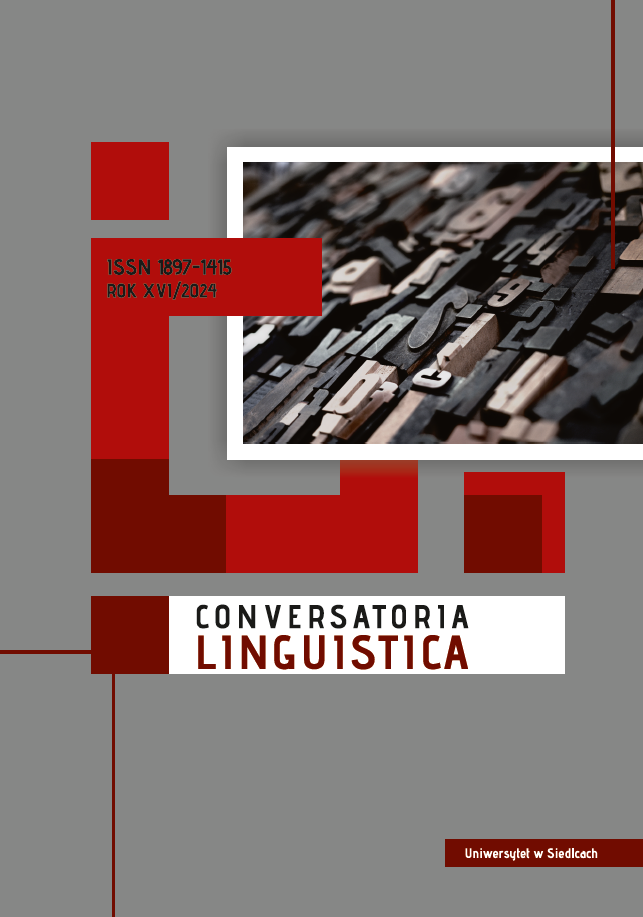Łaciński czasownik vīdī oraz jego odpowiedniki w językach germańskich i słowiańskich
DOI:
https://doi.org/10.34739/clg.2024.16.07Słowa kluczowe:
gr. oĩda, lat. vīdī, gmc. *witan, OCS vědě, ang. wit, pol. wiedziećAbstrakt
Artykuł przedstawia krótki rys historyczny rozprzestrzeniania się łaciny w Eu-ropie na tle społeczno-kulturowym, w tym kontaktów językowych. Łacina odcisnęła znaczące piętno na dziedzictwie kulturowym przed-, między- i pośredniowiecznego świata, ale nie była jedynym językiem związanym z prestiżem, religią i edukacją w dawnych czasach. Artykuł szkicuje podobieństwa, wzajemne relacje i kontakty między łaciną, greką, językami germańskimi i słowiańskimi (poświadczone w dokumentach, leksyce i systemach pisma tych ostatnich). W perspektywie mikro, niniejsze opracowanie koncentruje się na morfologicznych i semantycznych osobliwościach czasowników: gr. oĩda, lat. vīdī, gmc. *witan (ze szczególnym naci-skiem na ang. wit, wot, wist, weet, itp.) i OCS vědě (ze szczególnym naciskiem na pol. wiedzieć).
Pobrania
Bibliografia
Literature
Andersen H. (2021): On the formation of the Common Slavic koiné, in: New Perspectives on the Early Slavs and the Rise of Slavic: Contact and Migrations, Tomáš Klír, Vít Boček, Nicolas Jansens (eds.), Heidelberg, p. 11–42.
Barber C., Beal J.C., Shaw P.A. (2009): The English Language. A Historical Introduction (2nd ed.), Cambridge.
Bartula C. (2001): Podstawowe wiadomości z gramatyki staro-cerkiewno-słowiańskiej na tle porównawczym, Warszawa.
Beekes R.S.P. (2011): Comparative Indo-European Linguistics. An Introduction (2nd ed.), Amsterdam / Philadelphia.
Bennett W.H. (1980): An Introduction to the Gothic Language, New York.
Clackson J. (2007): Indo-European Linguistics: An Introduction, Cambridge Textbooks in Linguistics, Cambridge.
Darden B.J. (2018): Balto-Slavic morphology, in: J. Klein, B. Joseph, & M. Fritz (eds.), Hand-book of Comparative and Historical Indo-European Linguistics, Vol. 3, Berlin / Boston, p. 1985–2000.
Fulk R.D. (2018): A Comparative Grammar of the Early Germanic Languages, Studies in Germanic Linguistics, Vol. 3, Amsterdam / Philadelphia.
Hawes J. (2020): The Shortest History of England, Exeter.
Hogg R.M., Fulk R.D. (2011): A Grammar of Old English, Vol. 2, Morphology, Chichester.
Jackson H. (2002): Lexicography. An Introduction, London / New York.
Janson T. (2002): Speak. A short history of languages, Oxford.
Janson T. (2004): A Natural History of Latin (N. Vincent & M.D. Sørensen, Trans.), Oxford.
Klemensiewicz Z. (1976): Historia języka polskiego, Warszawa.
Krause T.B., & Slocum J. (2003): Old Church Slavonic Online (EIEOL-OCS). Linguistics Re-search Center, University of Texas at Austin, https://lrc.la.utexas.edu/eieol/ocsol, access date: 23.VI.2024.
Kuraszkiewicz W. (1972): Gramatyka historyczna języka polskiego, Warszawa.
Langston K. (2018): The documentation of Slavic, in: J. Klein, B. Joseph, & M. Fritz (eds.), Handbook of Comparative and Historical Indo-European Linguistics, Vol. 3, Berlin / Boston, p. 1397–1413.
Lehr-Spławiński T. & Bartula C. (1973): Zarys gramatyki języka staro-cerkiewno-słowiań-skiego, Wrocław.
Małecki A. (1863): Gramatyka języka polskiego. Większa, Lwów, https://po-lona.pl/preview/0dea085b-2e19-4cee-bc92-35e7a6afbf6a, access date: 23.VI.2024.
Oxford English Dictionary (OED), Oxford, https://www.oed.com/, access date: 23.06.2024.
Palmer L.R. (1954): The Latin Language, London.
Pokorny J. (1959): Indogermanisches etymologisches Wörterbuch, Vols. 1-3, Bern / München.
Ringe D.R. (2006): From Proto-Indo-European to Proto-Germanic. A Linguistic History of English, Vol. 1, Oxford.
Ringe D. & Taylor A. (2014): The Development of Old English. A Linguistic History of English, Vol. 2, Oxford.
Robinson O.W. (1992): Old English and its closest relatives. A survey of the earliest Germanic Languages, Stanford.
Sakhno S. (2018): The Lexicon of Slavic, in: J. Klein, B. Joseph, & M. Fritz (eds.), Handbook of Comparative and Historical Indo-European Linguistics, Vol. 3, Berlin / Boston, p. 1571– –1585.
Sanders R.H. (2010): German: Biography of a Language, Oxford.
Słownik pojęciowy języka staropolskiego (SPJS), Instytut Języka Polskiego Polskiej Akademii Nauk, https://spjs.ijp.pan.pl/, access date: 23.VI.2024.
Smyth H.W. (1920): A Greek Grammar for Colleges, Perseus Digital Library, the Department of Classical Studies, Tufts University, https://www.perseus.tufts.edu/hopper /text?doc=Smyth+grammar&fromdoc=Perseus%3Atext%3A1999.04.0007, access date: 23.VI.2024.
Tosi A. (2020): Language and the Grand Tour. Linguistic Experiences of Travelling in Early Modern Europe, Cambridge.
Pobrania
Opublikowane
Numer
Dział
Licencja
Prawa autorskie (c) 2024 Conversatoria Linguistica

Utwór dostępny jest na licencji Creative Commons Uznanie autorstwa – Użycie niekomercyjne 4.0 Międzynarodowe.




